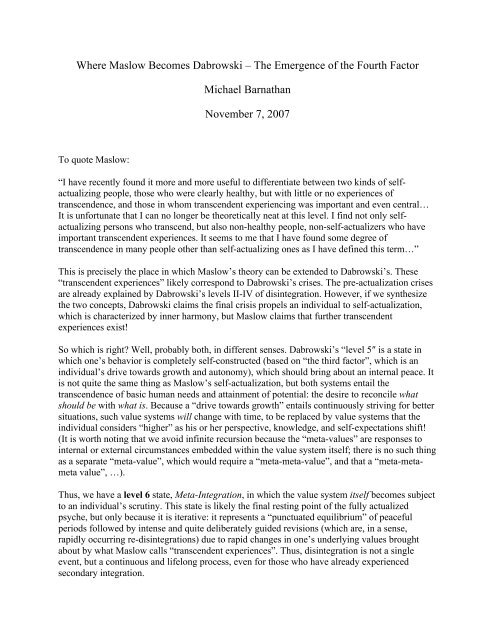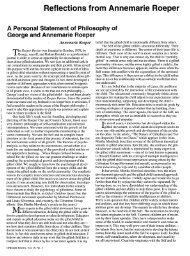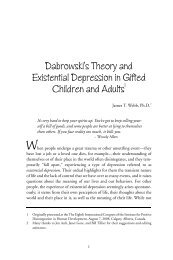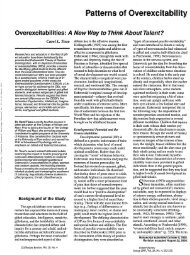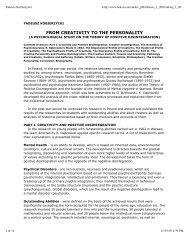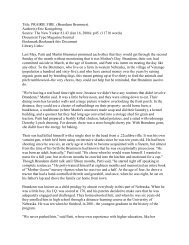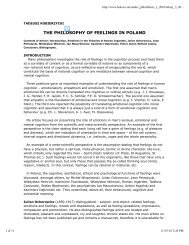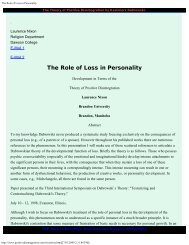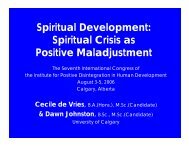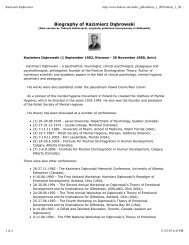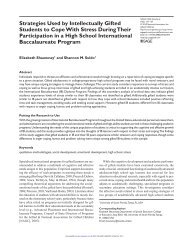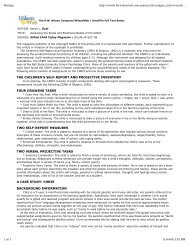Where Maslow Becomes Dabrowski â The Emergence of the Fourth ...
Where Maslow Becomes Dabrowski â The Emergence of the Fourth ...
Where Maslow Becomes Dabrowski â The Emergence of the Fourth ...
Create successful ePaper yourself
Turn your PDF publications into a flip-book with our unique Google optimized e-Paper software.
<strong>Where</strong> <strong>Maslow</strong> <strong>Becomes</strong> <strong>Dabrowski</strong> – <strong>The</strong> <strong>Emergence</strong> <strong>of</strong> <strong>the</strong> <strong>Fourth</strong> FactorMichael BarnathanNovember 7, 2007To quote <strong>Maslow</strong>:“I have recently found it more and more useful to differentiate between two kinds <strong>of</strong> selfactualizingpeople, those who were clearly healthy, but with little or no experiences <strong>of</strong>transcendence, and those in whom transcendent experiencing was important and even central…It is unfortunate that I can no longer be <strong>the</strong>oretically neat at this level. I find not only selfactualizingpersons who transcend, but also non-healthy people, non-self-actualizers who haveimportant transcendent experiences. It seems to me that I have found some degree <strong>of</strong>transcendence in many people o<strong>the</strong>r than self-actualizing ones as I have defined this term…”This is precisely <strong>the</strong> place in which <strong>Maslow</strong>’s <strong>the</strong>ory can be extended to <strong>Dabrowski</strong>’s. <strong>The</strong>se“transcendent experiences” likely correspond to <strong>Dabrowski</strong>’s crises. <strong>The</strong> pre-actualization crisesare already explained by <strong>Dabrowski</strong>’s levels II-IV <strong>of</strong> disintegration. However, if we syn<strong>the</strong>size<strong>the</strong> two concepts, <strong>Dabrowski</strong> claims <strong>the</strong> final crisis propels an individual to self-actualization,which is characterized by inner harmony, but <strong>Maslow</strong> claims that fur<strong>the</strong>r transcendentexperiences exist!So which is right? Well, probably both, in different senses. <strong>Dabrowski</strong>’s “level 5″ is a state inwhich one’s behavior is completely self-constructed (based on “<strong>the</strong> third factor”, which is anindividual’s drive towards growth and autonomy), which should bring about an internal peace. Itis not quite <strong>the</strong> same thing as <strong>Maslow</strong>’s self-actualization, but both systems entail <strong>the</strong>transcendence <strong>of</strong> basic human needs and attainment <strong>of</strong> potential: <strong>the</strong> desire to reconcile whatshould be with what is. Because a “drive towards growth” entails continuously striving for bettersituations, such value systems will change with time, to be replaced by value systems that <strong>the</strong>individual considers “higher” as his or her perspective, knowledge, and self-expectations shift!(It is worth noting that we avoid infinite recursion because <strong>the</strong> “meta-values” are responses tointernal or external circumstances embedded within <strong>the</strong> value system itself; <strong>the</strong>re is no such thingas a separate “meta-value”, which would require a “meta-meta-value”, and that a “meta-metametavalue”, …).Thus, we have a level 6 state, Meta-Integration, in which <strong>the</strong> value system itself becomes subjectto an individual’s scrutiny. This state is likely <strong>the</strong> final resting point <strong>of</strong> <strong>the</strong> fully actualizedpsyche, but only because it is iterative: it represents a “punctuated equilibrium” <strong>of</strong> peacefulperiods followed by intense and quite deliberately guided revisions (which are, in a sense,rapidly occurring re-disintegrations) due to rapid changes in one’s underlying values broughtabout by what <strong>Maslow</strong> calls “transcendent experiences”. Thus, disintegration is not a singleevent, but a continuous and lifelong process, even for those who have already experiencedsecondary integration.
Here we have two separate processes being described as if <strong>the</strong>y are common approaches, when inreality, <strong>the</strong>se are intrinsic responses, <strong>the</strong> first <strong>of</strong> which <strong>the</strong> great majority <strong>of</strong> individuals willadopt. <strong>The</strong> second response is only reserved for people who really should be classed at a lowercognitive level, for <strong>the</strong>y are only governed by <strong>the</strong> first factor.Thus my complete <strong>the</strong>ory has eight total levels and spans a wider range <strong>of</strong> cognitivedevelopment than <strong>Dabrowski</strong>’s by extending <strong>the</strong> endpoints in both directions.


